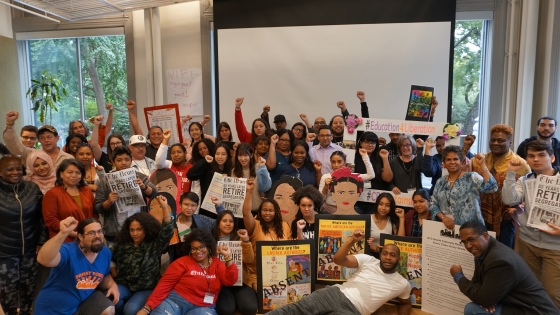“When children cannot find themselves reflected in the books they read, or when the images they see are distorted, negative, or laughable, they learn a powerful lesson about how they are devalued in the society of which they are a part.” - Rudine Sims Bishop, Professor Emerita of Education at Ohio State University, Author
Referred to by some as the “Mother” of multicultural children’s literature, Professor Rudine Sims Bishop’s scholarship highlighted the important self-affirming role that literature plays in the lives of young readers. Sims Bishop was one of the first to comment that “Literature transforms human experience and reflects it back to us, and in that reflection we can see our own lives and experience as part of the human experience.” This actuality is especially true of public school students across North America.
Students in the United States come from a large and increasing number of racially, ethnically, culturally, and linguistically diverse families. NYU Metro Center conducted a recent analysis of major curriculum publishing companies’ publicly available reading lists. Despite the diversity within the US, it found that the content of English Language Arts curriculum for elementary school students fails to reflect the diversity of public school’s student population. While Black, Indigenous, and students of color make up nearly 54% of public school students, more than half of the books they read are written by White authors and feature mainly White characters.
Researchers from the Education Justice Research and Organizing Collaborative (EJ-ROC) at NYU Metro Center analyzed major publishing companies’ reading lists for Kindergarten to 5th grade — Houghton Mifflin Harcourt Into Reading, McGraw Hill Wonders, and Savvas ReadyGEN and myView. The study found:
- Among the 139 authors in the McGraw Hill Wonders reading list, there were only 2 Native American authors and 3 Native American characters.
- Of the 102 authors present in Houghton Mifflin Harcourt Into Reading focal texts, there were only 3 Black authors and 0 Native American authors.
- Out of the 65 books sampled for Savvas ReadyGEN, there was only 1 Latinx character and 1 Latinx author, 0 Native American authors and 3 Native American characters.
- 58% of authors of Savvas myView reading list are White, and out of the 150 authors, only 3 are Native American.
A recent NYU Metro Center report showed that widely used elementary school English Language Arts (ELA) curricula - McGraw Hill Wonders, Savvas myView, and Houghton Mifflin Harcourt Into Reading - fail to provide culturally responsive education.
As the GPS of the classroom, curriculum prepares students to navigate both their academic learning and their role in the society at large. Major curriculum publishers are failing to integrate models of culturally responsive education that could advance student academic learning, build cultural competency for a diverse world, and develop critical thinking. These are essential building blocks that students will need to participate in a diverse and complex society, and to lead us to a more just and equitable world for generations to come.
Rigorous studies have shown that culturally responsive education (CRE), an instructional approach that centers students’ diverse cultures, identities, and backgrounds, increases student academic engagement and positive self-definition for students of color as well as White students. Our research indicates that there is an urgent need for public school curricula to represent full, complex characters from traditionally marginalized groups, so that all public school students can have a more holistic understanding of themselves and others, as well as possess the necessary skills to navigate the diverse society they are growing up in. Our findings recommend shifting the “narratives” and point of view shared in public school classroom texts, from singular to multiple perspectives. Our analysis also underscores the need for providing educators with guidance to facilitate the bridging of cultural gaps with their students and adapting to the cultures, backgrounds, and experiences in their classrooms.
An ideal learning environment is one where all public school students are encouraged to be critical thinkers and empowered to question the dominant narratives, so that students can actively participate in creating new policies and practices for a more just and equitable society.
To review a more detailed author and main character analysis of elementary ELA reading lists, please download our findings here.

